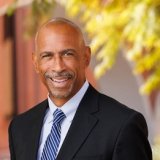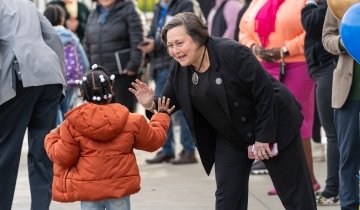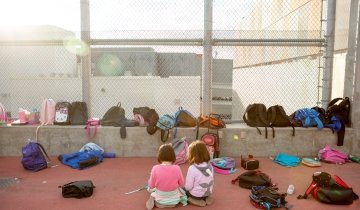In February 2022, Los Angeles Unified School District welcomed a new superintendent, Alberto Carvalho. Carvalho, an immigrant from Portugal, began his career in education at Miami-Dade County Public Schools in Florida, where he was a science teacher. After serving as an assistant principal, Carvalho moved to Miami-Dade’s central office, where he served in various roles including chief communications officer and assistant superintendent. In 2008, Carvalho was tapped for the role of superintendent. His 14 years at the helm of one of the largest urban districts in the nation would see it rise to one of the highest performing. A self-described “eternal optimist,” Carvalho intends to lead LAUSD toward sustained improvement. In late October, Carvalho discussed his plans for the district with Dean Pedro Noguera.
Pedro Noguera: I was very enthusiastic about you coming to L.A. because of your work in Miami. There are very few superintendents around the country who have the kind of longevity you had and almost none who’ve done it in an urban district. Under your leadership, Miami schools experienced significant improvements. Now you’re in L.A., a district that has proved challenging for many superintendents. So far, what have you found to be most surprising, most different, from your experience in Miami?
Alberto Carvalho: Well, number one, the political structure is different. The governance style is different. The level of activism in this community, from a very positive perspective, really lifts all voices. [There are] differences also in terms of the administrative element within LAUSD compared to Miami. LAUSD has a very stratified system of management. Anything that’s discussed, said, contemplated or approved at a central level is distanced from what happens in a classroom. That’s significantly different from Miami. The level of coherence, level of autonomy and the decision-making processes in Los Angeles Unified are very diversified and local, as opposed to Miami, where the adoption of curriculum decisions regarding textbooks, basal series, technology [and] progress-monitoring tools were pretty coherent and universal.
Do you feel like you’re going to try to make LAUSD more like Miami, to make it more centralized? Or are you going to keep it the way it is?
We’re going to find a new balance. I believe that the decentralization and autonomy movement that took place over the past few years may have gone too far. The reason why I say that is there are a number of practices—whether we’re talking about the curriculum that’s being followed, support systems or progress-monitoring tools—that may vary within a single school. They may vary wildly across two or three schools within the same ZIP code. Considering the level of mobility experienced by students and their families, students should not be seeing something so different and disconnected by moving from one school [to another] less than a mile away.
We are going [to go] from six local district regions to four regions. We are providing a greater level of coherence, and we are embarking on decisions via RFP (request for proposals) processes to arrive at best-in-class standards-aligned curriculum [and] progress-monitoring tools that are more universal, but with input from folks from the field. It’s a balance between central decisions but also local implementation. We’re not going to re-centralize every single function, but we are re-centralizing some functions while beefing up local control in other areas. And we’re going to move in the direction of earned autonomy, meaning there’s a large percentage of our schools [that] are doing fairly well to very well [and that] ought to be left alone. But for schools that are hugging the bottom, we’re going to provide disproportionate support [and] funding, but also significantly augmented accountability by the central office.
One of the issues that comes up often in L.A. is whether the district is too large. Do you think the district should be broken up and split into smaller districts?
I actually don’t. I’ve studied this. I’ve looked at the performance of larger districts [and] midsize districts. Miami is not only one of the largest districts in the country—it’s now the third largest in terms of enrollment. And its performance, according to two administrations of NAEP (National Assessment of Educational Progress) is number one in the country out of the 27 TUDA (Trial Urban District Assessment) districts. So, is being that large detrimental to educational attainment? I don’t think so.
What I do believe, however, is that there ought to be a degree of coherent theory of action that is seen in districts regardless of size. I do believe that under my realignment plan that takes the district from six local districts into four regions, with greater agreement regarding curriculum, materials support, coherent funding that’s differentiated on the basis of need and progress-monitoring tools, [that] the size of the district [will be] inconsequential.
When you started your service as superintendent, you announced that you had a 100-Day Plan, but since then you’ve been faced with cyberattacks, fentanyl overdoses and a number of challenges that I am sure you hadn’t anticipated. What do you see as the biggest challenges facing the district now that you’ve been here for over half a year? And are you concerned about your ability to implement a proactive agenda when you’re fending off these kinds of unexpected matters that you have to contend with?
Certainly they are a potential threat to the agenda, to the mission. I think this district actually navigated [the ransomware attack] in a very able way. We didn’t succumb to the pressures; we never stopped the educational process. Kids were back in school after Labor Day, despite the fact that some of our systems were crippled. We’re dealing with a fentanyl crisis, but we took swift action. We deployed Narcan to schools, a massive awareness campaign [and] external entities to assist us.
Those are just two examples but, look, the strength and the resilience of this system is proven. Time and time again, we are adamant about literacy, graduation, postsecondary success [and] the identification of the most fragile schools in the district and providing additional support and accountability to those schools. We were the only large-scale district to open the school year with every single teacher vacancy filled, even if it was through the redeployment of credentialed individuals who were working outside the classroom, back into the classroom.
We’ve dealt with a number of challenges that could have derailed the progression and the implementation of the strategies laid out either in the 100-Day Plan or in the now-adopted—[for the] first time in 10 years—strategic plan. But we have stayed the course, not really allowing [ourselves] to be thrown off balance because of the significant events that could destabilize our school system.
That’s very impressive. Just the fact that at a time when there are so many districts with teacher shortages, that you can ensure that all the classrooms were staffed by certified teachers is very impressive. Could you explain for our readers why declining enrollment is a threat to the district, and what you’re approaching to respond to this challenge?
In California, education is funded on the basis of two critical elements: enrollment, and I don’t agree with this second element, average daily attendance. Those are two issues that are significantly impacting the financial viability of our school system.
With that said, let’s be real. There are a number of factors that continue to influence enrollment rates in Southern California [including] declining birth rates in Los Angeles [and the] high cost of housing, which drives families to move to more affordable areas, whether it is within the state or outside California. While it’s true that the bulk of our funding is tied to the average daily attendance rates, we are far more concerned about the number of students we estimate are out there but not in school.
I just painted a bleak perspective as to what are the contributing factors to declining enrollment in Los Angeles and, quite frankly, across America in most large urban districts. There is a bit of a silver lining, however. This year we were bracing ourselves for a 4.1% decline in enrollment. We were pleasantly surprised because, rather than decreasing by 4.1%, enrollment [dropped] by 1.9%—you’d have to go back a full decade to [see] that low [of a] decrease. That’s a good early indicator. We’re seeing significant improvement in terms of TK (transitional kindergarten) and kindergarten enrollment, which is great news. You and I have taken the positions on that matter.
We’re seeing also significant improvements across the board in specific grades, in terms of kids not only coming back from other forms of publicly funded education, but kids who were never enrolled in the school system, and have been in this community for [years], becoming members of our family. So, something is happening. We’re knocking on doors, we’re making calls. We are re-engaging communities that disengaged from our school system. Based on the data for this year, we may be in a position of beginning to curb that declining enrollment trend, which has been so pervasive in Los Angeles.
That’s good news. I did see an article in The 74 that looked closely at the schools in LAUSD that have experienced significant decline in enrollment, but it sounds like you’re saying that enrollment is starting to stabilize with respect to enrollment.
There is a degree of stabilization. This bucking of the trend of the past decade is being driven disproportionately by new excitement with [enrollment of] young kids. That’s why we made significant investments in dramatically expanding TK early education programs. Los Angeles Unified just launched a baby initiative where we are greeting every single birth at the maternity ward at the hospital with a box from LAUSD, with resources [and] a rolled-up diploma with a perspective graduation date for that child. The reason why we’re doing that is—the research is pretty strong—if you capture families’ and kids’ attention early on, more than likely they will graduate with you. That’s exactly what we’re doing.
At the same time, we are reinventing public education choice to excite communities at the middle school level and even at the senior high school level with a second look of opportunity at our school system. I think that combination of strategies will actually work.
I’m going to show you one thing: This is the box; this is our most powerful recruitment tool. We’re going to turn LAUSD from a K–12 institution into a B–14 institution, starting with babies: early screening, good-quality child care programs, TK opportunities within your neighborhood, connections with health care institutions, family and parent academy instructional opportunities. We added in excess of 3,000 kids to our TK programs. We expect we’ll enroll another 6,000 by next year. So, I am pretty confident that we’re going to finally buck the trend of declining enrollment in the second-largest school system in the country by this coming academic year.
That’s very impressive. I’ve told you several times since you arrived in L.A. that USC wants to be a partner with you in this work. In the coming months, we’re working with President Folt to convene all 22 schools at USC, to consider how we can build upon existing partnerships with local schools to increase our impact on student outcomes. For example, we’re thinking about getting the medical school, social work and others, working with USC Rossier to support children, families and educators. We’ll be in touch about what comes out of this important gathering.
Let’s close with this, Alberto. When you came to L.A., I used the analogy that bringing you to L.A was like the Lakers acquiring LeBron James. So, if I stick with that analogy, despite his great track record, LeBron is having some trouble with the Lakers right now. The team as a whole is not looking so good, and part of the problem appears to be that he doesn’t have the team he needs to win consistently. What about you? Do you feel like you have the team in place to get the work that needs to be done accomplished?
I do. With that said, we have released to the board the realignment and reorganization plan that has created a number of new positions, and I’ll give you a couple of examples. I’m creating an educational transformation position that’s going to concentrate all efforts on the most fragile schools in the district [and] incorporating our work regarding BSAP (the Black Student Achievement Plan) and HEET (Humanizing Education for Equitable Transformation). This is a critically important position [that will] advocate and lift the needs of these schools at all levels of the central office.
Secondly, we created an eco-sustainability officer who will make decisions that will impact how we procure, who we contract with, the whole issue of shading in schools [and] greening of schools [as well as] maintenance efforts to improve outdoor learning spaces.
But, by and large, I have gotten to meet, know [and] understand the team that was here prior to my arrival. There is immense talent at the central level, the local district level and the schools. What has lacked is not raw talent, expertise [or] skill. What I found was lacking was the interconnectedness between different divisions, breaking down silos and creating systems of support that, at the end of the day, elevate the potential in schools.
I have the team members I need, and I have the team members that go beyond Beaudry (LAUSD headquarters) and the over 1,000 schools at LAUSD, which are institutions like USC, private sector support, other forms of government support [and] community-based organizations.
That’s where we are at this point, ensuring that everybody is plugged in at the right level of pressure, and to accelerate the implementation of our strategic plan to [combat] the regression that we observed as a result of the pandemic. We’re seeing early indicators, the NAEP data just released, [that] even though we are performing at a lower level than the nation’s schools, LAUSD can brag about the fact that we are the only district in the country that in three out of the four assessed areas—fourth-grade reading and math, eighth-grade reading and math—we only lost ground in fourth-grade mathematics. We lost four points; the nation as a whole lost five points. The 27 largest city-school systems lost eight points in fourth-grade reading. In eighth grade math, we gained two points, while the country lost [points]. In eighth grade reading, we gained nine points when the nation and large cities lost considerable ground.
I think those data points are a result of a better-than-national-average transition to virtual environments with the [necessary] tools, devices, one-to-one solutions [and] connectivity, in addition to strategic professional development, summer school [and] high-dosage tutoring programs that have targeted in excess of 100,000 students who absolutely need more teaching and learning opportunities.
It’s working—we’re seeing positive movement [in] enrollment. We’re seeing early indicators as far as NAEP is concerned. Our budget is stable. We are at the table with our labor partners, and there’s real community excitement about what’s happening in our school system.
Look, I’m the eternal optimist. I’m in Los Angeles because I think the potential for Los Angeles to actually become the premier district in America is rather strong, and I will not tire until we surpass where I left Miami. That’s the goal.





